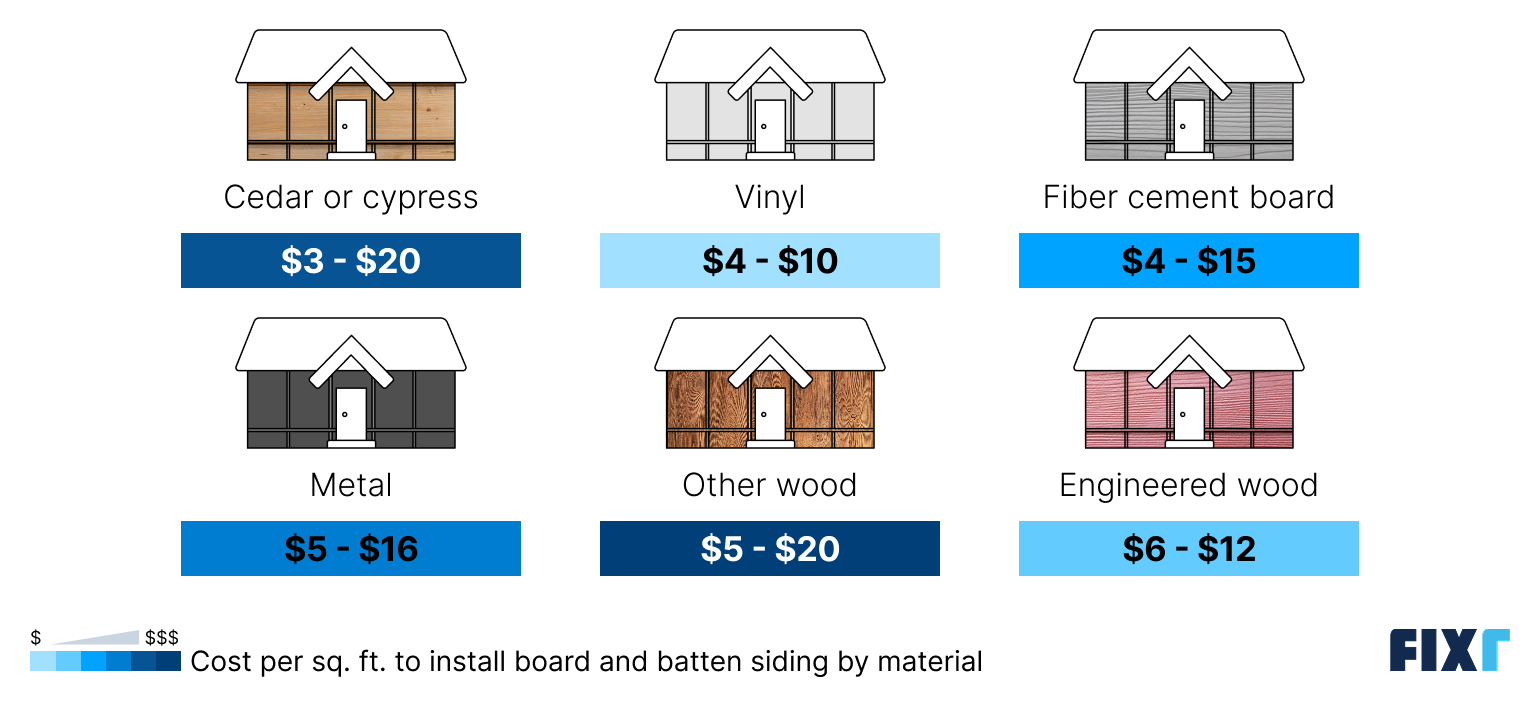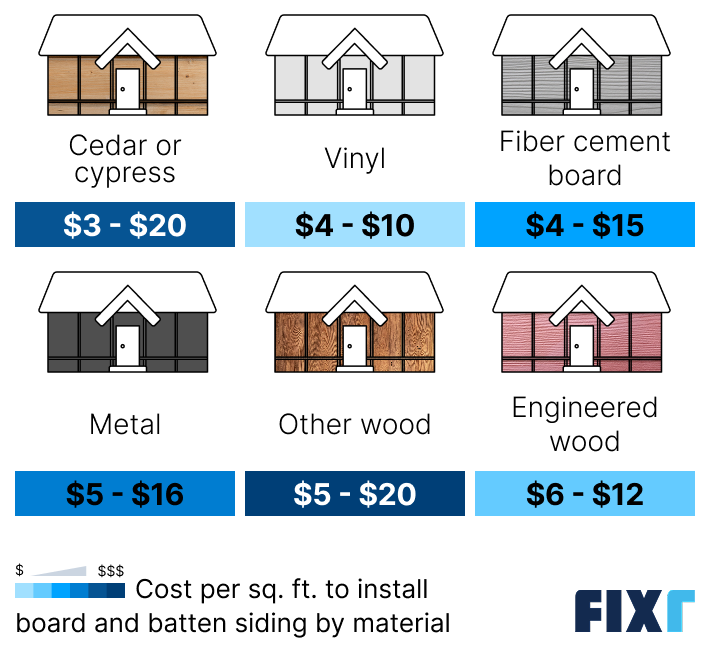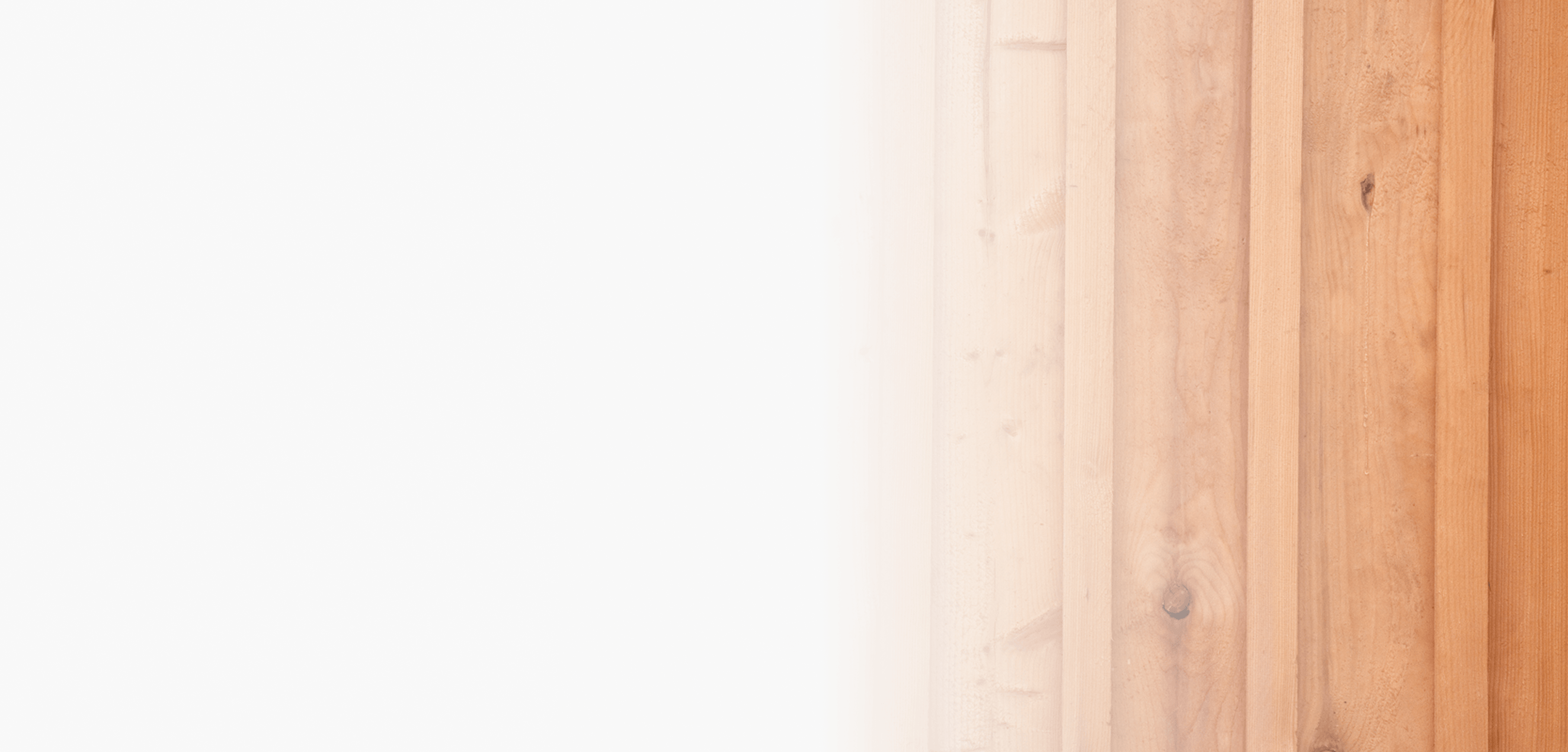Updated: October 28, 2025
Written by Dan Simms
Nieves is a home remodeling editor at Fixr.com with special interest in landscaping, pest control, painting, installation, and repair projects. She brings her work ethic, creativity, and love for teamwork into everything she does, including working with writers and designers at Fixr.com to develop useful and comprehensive guides for homeowners.
Learn moreReviewed by Nieves Martinez
Board and batten siding is an increasingly popular siding type, as it offers a unique curb appeal and matches a variety of home styles, particularly modern farmhouse and rustic homes. Rather than the common horizontal pattern you’d get with lap vinyl siding, board and batten siding creates verticality on your home, combining large, flat boards of material with thin vertical pieces covering the seams between them.
The national average cost of board and batten siding is $14,000, and most homeowners pay somewhere between $7,500 and $23,000 for the materials and installation labor. Your price will depend mostly on the size of your home and the type of siding material you choose, but the complexity of your home and local labor costs also play a role.
Cost of Board and Batten Siding


Board and Batten Siding Cost per Square Foot
On average, prices can range from $4 up to $13 per square foot for board and batten siding, depending mostly on the materials you choose.
Keep in mind that the square feet of siding you need isn’t equal to your home’s total square footage. For the most accurate cost estimate, measure all faces of your home that need to be sided and add the square footage calculations together.
You can also use the table below for a rough estimate based on your home's size, or contact a professional for a more precise quote. Expect higher costs for larger homes simply due to the increased material and labor required.
Home Size (Square Feet) | Sq. Ft. of Siding Needed | Average Cost Range |
1,000 | 1,200 – 1,300 | $4,800 – $16,900 |
1,200 | 1,400 – 1,600 | $5,600 – $20,800 |
1,500 | 1,600 – 1,800 | $6,400 – $23,400 |
2,000 | 1,800 – 2,000 | $7,200 – $26,000 |
2,500 | 2,000 – 2,200 | $8,000 – $28,600 |
3,000 | 2,300 – 2,500 | $9,200 – $32,500 |
Board and Batten Siding Cost by Material
Traditionally, board and batten siding is made from cedar wood, but given the rise in popularity of the siding design, material options for board and batten siding now include vinyl, fiber cement board, metal, and engineered wood. The material you choose will have a major impact on your siding installation costs, but it also determines the lifespan, curb appeal, energy efficiency, and more.


Siding Material | Cost per Square Foot |
Cedar or cypress | $3 – $20 |
Vinyl | $4 – $10 |
Fiber cement board | $4 – $15 |
Metal | $5 – $16 |
Other wood | $5 – $20 |
Engineered wood | $6 – $12 |
Cedar
Wood board and batten siding costs between $3 and $20 per square foot, with cedar usually costing a bit less than cypress. Board and batten siding is traditionally made from cedar, so the material is widely available. However, it can rot in humid or rainy areas, and it’s one of the least fire-resistant siding materials.
Vinyl
Vinyl siding is the most common siding material in general, but board and batten vinyl siding is less common as a specific style. If you can find a manufacturer and installer near you, the vinyl siding cost for board and batten ranges between $4 and $10 per square foot for the materials and installation. Vinyl is a less environmentally friendly material, but it stands up extremely well to water and moisture. It’s not the most fire-resistant option, though, nor does it offer the nicest curb appeal.
Fiber Cement
Fiber cement siding, also called Hardie board siding, is an increasingly popular option due to its blend of affordability, durability, and adaptability to a variety of climates. It’s far more fire-resistant than traditional wood board and batten siding, making it a better choice in areas that are prone to wildfires. It’s also better in areas that see a lot of rain and humidity, as it resists rot better. Fiber cement board and batten siding costs $4 to $15 per square foot.
Metal
Board and batten metal siding costs between $5 and $16 per square foot, with steel board and batten siding costs usually being higher than what you’d pay for aluminum siding. Metal siding offers some of the best fire resistance, but it can dent and may not be suitable in areas where blown debris is a concern, like cities that are prone to hurricanes, tropical storms, or tornadoes.
Other Wood
Board and batten siding can be made from a variety of wood species beyond cedar and cypress. The cost for these other woods typically ranges from $5 to $20 per square foot. Woods like fir and pine are often more affordable and readily available, but they require regular maintenance and sealing to prevent rot and insect damage. Redwood is another option, known for its natural resistance to decay and insects, which can make it a more durable and expensive choice.
Engineered Wood
Engineered wood board and batten siding costs between $6 and $12 per square foot. It doesn’t provide the same warm look or high-end curb appeal as real wood, but it’s more resistant to rot and has greater fire resistance. It can also be a more eco-friendly option than other materials, as some manufacturers make it out of recycled wood.
Labor Cost to Install Board and Batten Siding
Labor costs will vary based on the local cost of living in your area, the complexity of your home design, and the number of floors you have, but on average, you can expect installation labor for board and batten siding to cost between $1.75 and $5 per square foot.
Total costs could climb significantly higher if parts of your exterior are difficult to access, if you choose a heavier siding material, like fiber cement, or if your home design and layout mean your installers need to work around multiple corners and angles on your exterior walls.
Additional Cost Factors
The size of your home and the material you choose are the most important factors to consider to get an accurate estimate, but there are other cost factors you should think about to avoid surprises in your estimate.
Removal of old siding: While it’s possible to install new siding over existing siding, it’s usually best to remove the old material first. Many contractors include the removal and haul-away costs in their estimates, but if yours doesn’t, expect to add between $1,000 and $2,500 to your total.
Design complexity: The shape of your home and the number of exterior features like windows, doors, and bump-outs can significantly increase labor costs. The more cuts and angles an installer has to work with, the higher the total price.
Maintenance: Budgeting for routine powerwashing, which costs between $300 and $400, on average, is a good idea regardless of your siding material.
Permits and inspections: Most municipalities require permits for siding replacement, which can add anywhere from $150 to $1,500 to your total. This is a standard project cost for any siding job, and it's important to include it in your budget.
Geographic location: Where you live can affect your board and batten siding prices in two ways. First, labor costs vary based on the local cost of living, so you’ll pay more in high-cost cities and states. Second, your climate can influence what siding options are right for your home, which can play an important role in the overall costs.
Painting or staining: If you choose traditional cedar board and batten siding, you’ll need to paint or stain the material every few years to maintain good curb appeal and protection from the elements. Unless you can do the work yourself, you’ll need to budget around $3,000 every few years for staining and sealing. Vinyl and fiber cement board and batten siding don’t usually need painting or staining, so ongoing maintenance costs will be lower.
Add-ons: Some add-on services can help maximize curb appeal and home value. Exterior trim is often included in siding replacement, but you might want to budget extra for soffit and fascia replacements, or gutter replacement.
DIY vs. Hiring a Professional
Given the average cost of installation labor for board and batten siding, you could stand to save thousands if you chose to DIY the installation. However, while DIYing is possible, it’s best to leave the work to a siding installer. Board and batten siding installation is labor-intensive and demands specialized tools and expertise, especially for materials like fiber cement or metal.
Not only will professional installation usually result in a cleaner, more precise finish that maximizes curb appeal and enhances your home value, but a pro is also far less likely to make mistakes that could leave your home exposed to the elements. Hiring a pro means a lower risk of water damage and mold growth, and it can also lead to a better envelope around your structure, which can boost your home’s energy efficiency and help reduce your heating and cooling bills.
Repair vs. Replace
When you notice damage, leaks, fading, or poor curb appeal, you’ll first need to decide whether to repair or replace your siding. Siding repair costs an average of $2 to $16 per square foot, but it can cost up to $50 for some materials, and is almost always a more affordable option than total replacement. However, you should consider both the upfront price range and the long-term costs.
You should generally replace your siding if you’ve had ongoing issues with siding leaks, if your siding is reaching the end of its useful lifespan, or if the material has rot, mold, or is faded to the point where it’s no longer providing good curb appeal. Siding repair is usually best if your siding has more than half of its useful life left, if the damage is localized, or if there have been only minor issues. Before deciding, it’s a good idea to speak with a siding professional, who can estimate repair and replacement costs and advise which option makes the most sense for your home.
Benefits of Board and Batten Siding
Board and batten siding provides some enticing benefits for homeowners who can justify the relatively high upfront cost of siding installation. Generally speaking, siding replacement can fetch a strong return on investment (ROI). According to the Cost vs Value report 2025 fiber-cement siding replacement has an average ROI of 114%, while vinyl siding replacement averages 97%. While these figures aren’t specific to board and batten siding, its distinctive appearance and curb appeal could help boost your home’s value.
Beyond ROI, this siding style boosts curb appeal, adapts to many home designs, and can be made from materials that offer excellent durability and weather resistance. Its layered design provides solid protection against the elements, while the clean vertical lines add character and depth to your home’s exterior. It’s also easier to repair than some other styles, making it both a practical and visually appealing long-term upgrade that enhances value and longevity.
Ways to Save on Board and Batten Siding Installation
Board and batten siding is more time-consuming to install than other types like lap siding, and it often requires multiple people to maneuver the large, heavy boards into place. As such, installation can quickly get expensive. Luckily, there are a few ways to keep costs to a minimum.
Choose your materials wisely: Traditional cedar is often affordable and widely available, but compare options carefully. Choose one that fits your budget, complements your home’s style, and offers good durability and weather resistance, ensuring your siding last for many years
Think about your climate: Your siding is going to see a lot of wear and tear, so always make sure you choose your siding material with your local climate in mind. Some may be more affordable upfront, but if they increase risks like wildfires or water damage, the savings may not be worthwhile long-term.
Consider maintenance requirements: Some materials, like metal and vinyl, are low-maintenance and need less upkeep than others, like traditional cedar. Think about the ongoing time and monetary cost of siding maintenance before you choose a material.
Schedule installation during the off-season: If possible, schedule your siding project for the fall or early winter. Siding contractors are usually busiest in the spring and early summer, and higher demand during those times can sometimes mean increased labor rates. If you live in a colder climate, though, avoid installation during the winter, as you’ll face higher heating costs while your home improvement project is underway.
DIY what you can: Taking on your own siding removal on your own and hauling it away, for example, could save you up to $2,500. Painting or staining your board and batten siding after installation could save close to $3,000 and is DIYable for handy homeowners.
Get at least three estimates: Get estimates from at least three local siding installers so that you can compare based on the quality of the materials and labor. You can also rule out unusually low estimates, which may come from installers who would cut corners to keep prices low.
FAQs
Board and batten is a siding design that involves large panels, called boards, that span vertically on your exterior walls, with thin strips of material covering the seams between the boards. The design is a sought-after one that can boost curb appeal and help maximize home value. Traditionally, board and batten siding is made out of cedar wood, but more options, like vinyl, fiber cement, and even metal, have become available in the recent past.
Board and batten siding is usually more expensive than simpler designs, like traditional lap siding, primarily because the installation requires more careful measurements and planning, and maneuvering the large boards into place requires multiple people. On average, you can expect to spend $4 to $13 per square foot of board and batten siding you need installed.
One of the biggest downsides of board and batten siding is the upfront cost. The design requires multiple installers to place large and heavy boards of material on your exterior walls, which can get particularly expensive if your home has multiple floors. Board and batten siding is also most often made of wood, which is prone to rotting and has low fire resistance, meaning it’s not ideal in areas where wildfires are a concern.
The cheapest way to do a board and batten on your home’s exterior is to choose a builder’s grade fiber cement siding, which comes with the lowest potential material cost per square foot. You can also keep costs down by removing and hauling away your old siding yourself, and by painting your new siding rather than buying pre-painted materials or hiring a pro to paint it for you.
